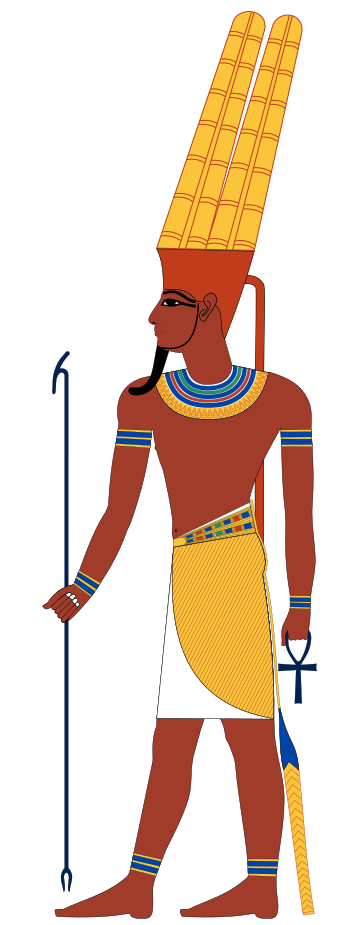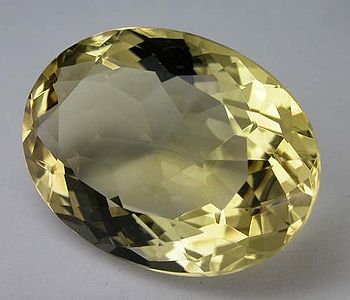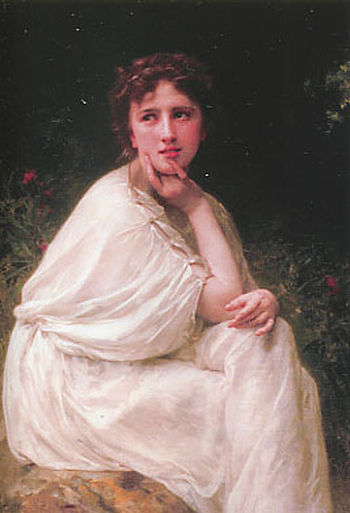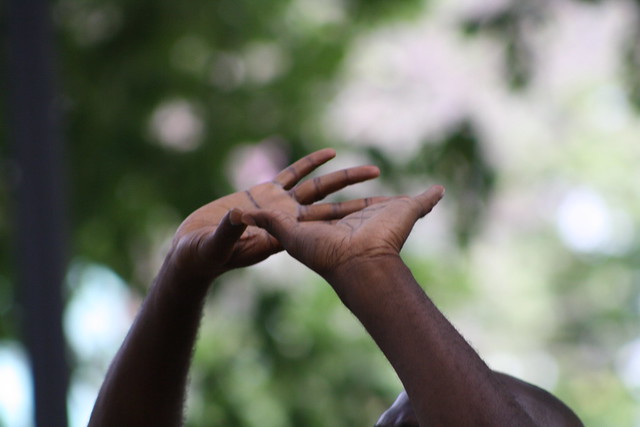 Amun, an ancient Egyptian god. Amun is usually shown as a striding man wearing a tall, plumed crown. Originally, Amun was depicted with red-brown skin but after the Amarna period, he was painted with blue skin, symbolizing his association with air and primeval creation. Amun was also depicted in a wide variety of other forms. Wilkinson, Richard H. (2003). The complete gods and goddesses of ancient Egypt. London: Thames & Hudson.
Amun, an ancient Egyptian god. Amun is usually shown as a striding man wearing a tall, plumed crown. Originally, Amun was depicted with red-brown skin but after the Amarna period, he was painted with blue skin, symbolizing his association with air and primeval creation. Amun was also depicted in a wide variety of other forms. Wilkinson, Richard H. (2003). The complete gods and goddesses of ancient Egypt. London: Thames & Hudson.
(Photo credit: Wikipedia)
What is the loop of Creation? How is there something from nothing?
In spite of the fact that it is impossible to prove that anything exists beyond one’s
perception since any such proof would involve one’s perception (I observed it, I heard it, I thought about it, I calculated it, and etc.), science deals with a so-called
objective reality “out there,” beyond one’s perception professing to describe Nature objectively (as if there was a Nature or reality external to one’s perception). The shocking impact of
Matrix was precisely the valid possibility that what we believed to be reality was but our perception; however, this was presented through showing a real reality wherein the perceived reality was a computer simulation. Many who toy with the idea that perhaps, indeed, we are computer simulations, deviate towards questions, such as, who could create such software and what kind of hardware would be needed for such a feat. Although such questions assume that reality is our perception, they also axiomatically presuppose the existence of an objective deterministic world “out there” that nevertheless must be responsible for how we perceive our reality. This is a major mistake emphasizing technology and algorithms instead of trying to discover the nature of reality and the structure of creation. As will be shown in the following, the required paradigm shift from “perception is our reality fixed within an objective world,” to “perception is a reality without the need of an objective world ‘out there,’” is provided by a dynamic
logical structure. The Holophanic loop logic is responsible for a consistent and complete worldview that not only describes but also creates whatever can be perceived or experienced.
Stating that it is impossible to prove the existence of anything beyond one’s perception is not saying there is nothing beyond perception, only that if there is anything, then whatever that is, is indefinite. It could be argued that the existence of physical laws, the universal perception that the apple falls to the ground is proof of an objective reality. However, this universal agreement is also our perception. It could be argued that if we cannot decide what to perceive, and everybody perceives the same physical reality, then there must be some
lawfulness that dictates how we perceive and therefore, this lawfulness could be external to our perception. However, this lawfulness, as we shall see later on, is the precise lawfulness that creates a perception, the process of definition, which is not external to perception (this process creates the perceived and the perceiver, which then gives meaning to this process – a loop – but about that, later). It could be argued, that hitting our knee on the table – whether we believe in the table or not – will hurt. The table is external to our body, but not to our perception. What then is perception? It is relating, a process of definition, defining and thereby rendering meaningful what has been perceived.
What then is this process of definition? It is creating borders within which one’s perception gains meaning. The word “definition” comes from the Latin
de finire, meaning, making finite or limited. In Hebrew, the definition is HAGDARA (הגדרה), meaning, to the border. Any definition necessarily implies what the definition is not, or stated differently, to have meaning, whatever is defined explicitly includes the meaning by implicitly excluding everything else. Consequently, to define means to place the defined object within borders that by default create something beyond the borders of the definition. What is this something beyond the defined? The implicitly excluded everything else, or in other words, the indefinite. The paramount importance of incorporating the indefinite within a consistent logical structure cannot be overemphasized. The indefinite itself is a paradox, and incorporating it within the Holophanic logical structure engenders the loop of Creation where the
dynamic structure of
paradoxes is both the creative force of existence and also the proof of the necessity of existence.
To better grasp the impetus of Creation, let’s look at the indefinite and paradoxes. What does “indefinite” mean? Anything as long as it is not specified (not defined); anything that appears both within and beyond the borders of the definition and thereby rendering the border superfluous, which means, no border, no definition. If nevertheless, we would attempt to define the notion “indefinite,” then that’s a paradox because if we succeed, then it is defined, which contradicts its meaning – its indefiniteness – and the word “indefinite” means that it cannot be defined. This is an example of a paradox, that in essence means, if it is what it is, then it is not what it is, yet if it is not what it is, then it is what it is. A paradox is a creature that consists of a structure (how it is defined, the dynamic process on its way to stabilization) that contradicts its significance (what it is, the stabilized entity). What characterizes a paradox is the motion between its structure and significance, where the structure implies that its significance contradicts its structure and vice versa.
Another example of a paradox would be “wholeness.”
Wholeness (totality, infinite, boundless) can only be wholeness if we can find a way to define it so that it includes everything and there is nothing beyond it. However, if we define wholeness, then to have meaning, it must be bordered within the walls of the definition, which implies that there is something beyond this border, in which case it is not wholeness. Or in more formal language, wholeness is only wholeness if it is not wholeness, which is an inconsistency. If we are satisfied with that, then we have completed the definition of wholeness. However, if we try to include the
beyond created by our earlier definition within the borders of our next attempt at defining wholeness, then we gain a new definition of wholeness, which by the sheer structure of the process of defining creates a new
beyond. In this case, the process of defining wholeness will be consistent but incomplete, and wholeness will remain indefinite.
Contemplating the paradox of Creation, the ancient
Egyptian myth of Creation springs to mind, the myth of the self-creating god,
Amun (or Amon). Amun masturbated and swallowed his semen, after which he spit it out in the form of a ball, thereby impregnating his mother, the sky. And only then, was he born. Thus Amun was his own father. Those pious who discovered the illustrated version of this myth in Karnak covered up the erect phallus of Amun, and with it, this
story of Creation was laid into obscurity. The Holophanic model of Creation could regard this Egyptian myth as Amun
retromorphously creating himself. I have coined the word
retromorphous to mean, defining in retrospect, turning non-being into the potential of whatever the observation is made from, or in other words, creating the past from the present, creating the source from its outcome, which is the basis of complexity in the context of the loop logic. That is, only after Amun was born can he give meaning to his mother, the potential from which he emanated and to the process that created him (as represented by masturbation and incest) whereby he was born. Of course, neither the sky nor the masturbating Amun have meaning until Creation takes place
de facto and Amun emerges. I find this an enticing illustration of the basic paradox of existence.
So how can there be something from nothing? What is “nothing?” Nothing is what didn’t turn into the potential of something. If there was something from nothing, then that nothing would have turned into the potential of something, because when we ask, how is there something from nothing, we ask this question from something, when something already exists. If we take a deeper look at “nothing,” we’ll discover that “nothing” is a paradox. Any definition is something, so if we defined “nothing,” then it would become something, which contradicts its essence of being “nothing.” Another way of looking at “nothing” would be by means of it being something that is meaningless. That is, “nothing” could be something that does not relate and that no thing or no one relates to. That is, if there was something totally alone in the universe, then that would be nothing, but it would be meaningless. If such existed, its existence would be external to our perception, and as such, this “nothing” would be indefinite.
We said that the indefinite could be anything, as long as it is not specified (not defined). However, if we nevertheless tried to define “nothing” (the indefinite), what would we get then? Since “nothing” is non-definable, it is transparent as the object of our inquiry. So when we attempt to define it, all we have is what we put into it, which is the process of definition. “Nothing” stayed nothing, we didn’t define it, only made the process of definition explicit. “Nothing” gains meaning when we fail to define it; but having tried, we are left with a bonus, a something, which is our process of defining “nothing.” Creation of something from nothing is not a function of defining something, but a function of attempting to define “nothing.” And then, if that process of definition – which already is an existence – looks back at its origins, if this process of defining investigates into its own genesis, then what does it see? It sees itself. It sees the process of definition – self-reference.
If there is nothing external to perception, then this process of definition is the overall wholeness, the creator of meaning when it can relate to itself. However, to have meaning, the process of definition has to be defined; this definition would be a self-referential quasi-infinite and continuous process of establishing borders that create the indefinite beyond that establishes borders creating the indefinite beyond that establishes borders… which means, wholeness would continuously and forever fail to define itself while succeeding to define something – anything but itself.
Of course, both the totally defined and the totally indefinite are idealized notions that would be inconsistent with the Holophanic loop logic, nor can they be found in nature. The totally indefinite would be the total meaningless nothing, the kind of non-being that cannot be fathomed because if we would think about it, it would already be something. On the other hand, there can be no total definition either. I have used the term uncertainty of sameness to describe the logical impossibility of total definition. A defined entity can be said to have reached sameness — it is the same as itself — which means that it is, it exists as something definite, no matter which parameters defined in it. However, no sooner does our object achieve sameness than the uncertainty of sameness raises its ugly head. Could it have been defined differently? Yes, of course. Could it have additional parameters? Yes, of course. Could it have been defined more precisely? Yes, of course. This uncertainty of sameness is the indefinite included in the definition, which is the result of including the tools of definition in the definition. Since ‘a’ can only be defined as ‘a’ with meaning if it implies ‘not-a’ (the indefinite beyond the borders of the definition), and since ‘a’ can only have meaning as ‘a’ because it is different from everything else (the everything else is indefinite beyond the borders, which actually gives meaning to ‘a’), the meaning of ‘a’ depends on ‘not-a.’
When the meaning of something depends on the indefinite, on what our defined object is not, then this indefinite is necessarily included in the process of definition. This logical implication that perception of meaning is only possible if and only if the indefinite is included within the perception is the reason why the 19th century dream of a consistent and complete axiomatic system with only well defined (explicit) empty signs had to fail (see more about that in my article, The Loop Logic). In spite of the fact that logic is the fundament of algorithms and computer science, it had neither the aspiration nor the ability to be connected to the real world precisely because its propositions were so anemic regarding meaning. In the effort to exclude any hint of the indefinite, logical inference was confined to a binary type of world of true and false and lacking any correlation with life and experiencing. However, including the indefinite in the process of definition not only makes the loop logic the fundament of existence, but determines the necessity of existence. With the birth of Holophany, Heidegger’s question, “Why is there anything at all, rather than nothing?” becomes irrelevant. When existence is relations, and relating is the act of perceiving, and perceiving is the process of definition, then existence is the overall lawfulness, the isomorphous lawfulness of the process of definition – the loop of Creation. What is being perceived, what is being stabilized, which significance is brought to the foreground from the amorphous background of the indefinite, depends on the non-linear rules of complex interactions. Thus the loop logic emphasizes the creation of essents rather than their interactions.
Is there a lawfulness responsible for any and every existence? An electron and a dog are very different creatures; so what invisible lawfulness is responsible for the existence of both? What kind of lawfulness would fulfill such demands? The answer is, isomorphism — the same logical inner structure in entirely different representations. Whether an electron, a dog or the weather, each could be a different realization of the same inner logical structure. Creation of anything is the creation of meaning, which is an act of definition. The act of definition attempting to define itself is consciousness. So consciousness, or the soul if you wish, is not some invisible copy of our body carrying our identity, but the lawfulness of Creation expressed as our individual qualitative essence. Of course, it has been endlessly stated that we are God, that we are parts of God and similar phrases. This is true, but true in the sense that God is the lawfulness that unfolds Creation, and this lawfulness is inherent in all creation including the creatures therein. It could be argued, that a soul, a person is more than mere definitions and intellect. If this logic is the logic of anything and everything, then it should be able to delineate the logical structure of experience as well. Indeed.
Anything that has meaning has to be defined, which places it somewhere on the scale between the continuous and the discrete, between the indefinite and the definite. The indefinite, continuous, infinite tends in the direction of the meaningless, whereas the mean is at best imprecise. Experience is the process of attempting to define the indefinite. When we try to capture an experience in a description, we are actually defining our attempt at defining the indefinite. The experience is continuous whereas its description, the definition is discrete. Just as we can never define wholeness, we can never define the experience. Any description, any definition, is by nature discrete, whereas the net experience is continuous. So when we have an experience or perception and we become aware of having that experience, then we give it meaning by defining what it is. By doing this we create a discrete replica of the experience, yet the experience remains continuous and non-definable, non-discretizable. Experience is connected to learning. The person encounters something new. How do we know that something is new? Because it is inconsistent with our system. So when we interact with it, we have to integrate it, to assimilate it into our system. If we get something that was not new to the system, then our system would recognize it as part of itself. When that recognition does not occur, the system is interacting with something new. That is the impact. The system adjusts to include the new – that is the change. One’s selfhood is the path of changes following one’s experiences.
Our knowledge of the experience – whatever it might be that we experience – makes it exist for us. We could say, one only experiences when one is aware of experiencing. How do we know that we are aware of experiencing something? By experiencing it, we experience the awareness of experiencing. In this sense, experience and awareness of the experience, experiencing the awareness of the experience, being aware of experiencing the awareness of the experience, etc. is an infinitely continuous chain, which is what defines what experience is (not the interpretation of a specific experience, but experience in its general sense). And that’s the definition of experience: an infinite loop of the process of becoming aware.
When “nothing” is the limit of both the totally indefinite and the totally defined, then that’s like a circle of going from something to nothing to something to nothing, etc. The ‘going’ here means perception. “Nothing” is only a notion that has meaning if it has been perceived, in fact, a paradox. If it really is “nothing,” then it cannot be defined, and hence, it has no meaning. Yet if I relate to it, then it is something. So whenever I relate to “nothing,” whenever I say, Creation of something from nothing, that “nothing” has meaning for me, and hence, it is significance — it is something just like any other something. That is, the structure of “nothing” is the same structure as that of something. Essentially, something from nothing is formation, not Creation, since nothing is also something. Then what is Creation? Creation is rather the creation of nothing from something, because Creation is the process of definition, and when we define, we create the indefinite beyond the definition, which at its limit is nothing, and only then can we have something from nothing… Oh yes, the loop. A true loop is only such if it contains its own source. If nothing can be proven to exist external to perception, then logic must be a loop, and existence is a logical necessity inferred by the loop.
Including the indefinite in the process of definition has far-reaching consequences. It means that the tools of the definition are necessarily included in the definition. It means that meaning can only occur when there is both definition and also experience. It means that consciousness (whether it succeeds to define or not) must be part of science or any so-called objective endeavor. It means that any and all perception includes experience. The interaction with the indefinite, the experience, is what gives meaning to the defined. Perception, meaningful definition, can only occur in a highly flexible complex system that can learn and change. That’s the difference between us and an electron, which only has fixed relations, and consequently, limited interactions. An electron always succeeds in defining, or it would be more correct to say, it can only interact with what it succeeds in defining. If it encounters the indefinite, it assumes a state of superposition.
Where is God in the loop of Creation? If we wanted to define God, the totality, we could not define God, because by the act of definition we would create the beyond, what is beyond God, which contradicts God’s totality. Therefore, no definition of God would do justice to God, and every such definition would truncate God’s wholeness. If God is indefinable, then God is indefinite. If God is indefinite, then I create God by the implication of the act of definition – any definition, because every definition creates the beyond, the indefinite beyond the borders of the definition. In that sense, this is consistent with the statement that I create God by my perception (definition). This does not say that I perceive God, but that my perception implies the existence of the indefinite (God). This means that if I perceive a dog, this perception implies the existence of God. If I perceive that I perceive, then that implies the existence of God. If I perceive dust, a table, an idea, whatever, then that implies the existence of God. If I experience, then that implies the existence of God. That’s because any existence implies the existence of God. And that’s because any existence is such if it relates or is related to if it has meaning if even partially it has been defined, which means, its mere definition implies the indefinite beyond the borders of the definition, it implies God, the indefinable. So one cannot directly perceive God (perhaps that is why it was stated in the Bible that no one could see God’s face and live = exist – “no man shall see me and live…” – Exodus 33: 20), but only know about God by implication, which means, the implication of the indefinite – God – is what attributes meaning to any existence.
However, “God” does not equal “indefinite,” but the process that implies the existence of the indefinite is what could be said to be God since that’s the process of Creation. This is the process of Creation that both creates something, existence, and also nothing, the indefinite. This is why this logic is a loop.
© Clara Szalai






















